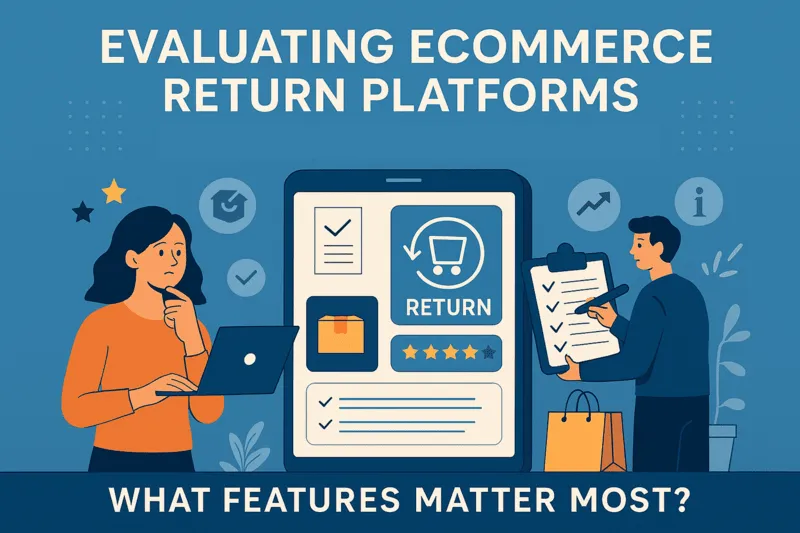Evaluating Ecommerce Return Platforms: What Features Matter Most?

Last updated on April 29, 2025

In this article
 12 minutes
12 minutes
- Introduction to Ecommerce Returns
- Why Ecommerce Return Platforms Matter
- Overview of Returns Management Systems
- Key Features to Look for in an Ecommerce Return Platform
- Example Ecommerce Return Platforms
- How Ecommerce Return Platforms Impact Revenue and Customer Loyalty
- Summary
- Frequently Asked Questions
The ecommerce order return process is not only inevitable but also a crucial part of the customer experience. A well-handled return process can improve customer satisfaction, enhance customer loyalty, and even drive future sales. However, poorly managed returns can lead to frustrated customers, lost revenue, and a damaged brand reputation. Additionally, hidden costs associated with ecommerce returns, such as shipping, restocking, and consumer behaviors like ‘bracketing,’ can significantly impact retailers.
To optimize this important aspect of the ecommerce business, more and more companies are turning to ecommerce return platforms. These platforms provide a comprehensive solution for managing returns management tasks and ensuring the returns process is as seamless as possible for both customers and businesses.
In this article, we’ll walk through the key features of ecommerce return platforms, explore what makes them a valuable tool for boosting customer loyalty and improving returns management, and highlight the benefits they bring to businesses in terms of efficiency and revenue retention. Whether you are a brand operator, a logistics expert, or a retail strategist, understanding the features that matter most in return platforms can help you make more informed decisions when choosing the right system for your ecommerce store.
Introduction to Ecommerce Returns
Ecommerce returns are an inevitable part of any online store’s operations. They can significantly impact customer satisfaction, revenue, and the overall success of an ecommerce business. Understanding the importance of customer satisfaction is crucial in managing ecommerce returns effectively. A well-implemented returns management system can boost customer loyalty, increase revenue retention, and enhance the overall customer experience. By streamlining the returns process and offering flexible solutions, businesses can turn returns into opportunities for building stronger customer relationships and driving future sales.
Make Returns Profitable, Yes!
Cut shipping and processing costs by 70% with our patented peer-to-peer returns solution. 4x faster than traditional returns.
See How It WorksUnderstanding the Importance of Customer Satisfaction
Customer satisfaction is the backbone of any successful ecommerce business. It is essential to recognize that returns are not just a necessary evil but an opportunity to build trust and loyalty with customers. By providing a seamless and efficient returns process, online stores can demonstrate their commitment to customer satisfaction, ultimately leading to positive word-of-mouth, repeat business, and increased future sales. Effective returns management software can play a vital role in achieving this goal by streamlining the return process, offering flexible exchange options, and enabling customers to initiate returns easily through an online portal. This not only enhances the customer experience but also helps businesses manage returns more efficiently and retain more revenue.
Why Ecommerce Return Platforms Matter
The Challenge of Managing Returns in Ecommerce
Returns are a natural part of the ecommerce experience, with the average ecommerce return rate ranging from 15% to 30%, depending on the industry. While returns are often seen as a necessary cost, they can be a significant drain on profit margins if not handled efficiently.
The returns process involves several steps that, when done manually, can become a time-consuming process for customer service teams. From receiving return requests to issuing refunds or store credit, and then handling shipping labels and reverse logistics, the manual handling of returns can quickly overwhelm a business. Many customers intentionally purchase items with the intention of returning some or all of them, adding complexity to the retail landscape. Furthermore, return fraud, inaccurate return shipping labels, and missed customer communication only add to the complications.
This is where ecommerce return platforms come into play. These platforms integrate and automate the returns management system, providing businesses with the tools they need to streamline the returns process and reduce costs while keeping customers satisfied.
Overview of Returns Management Systems
A comprehensive returns management system is designed to handle all aspects of ecommerce returns, from initiating a return to resolving the issue. This system should integrate with the online store’s existing tech stack, including popular apps and sales channels, to provide a unified and efficient returns process. Key features of a returns management system include automation rules, return shipping labels, and the ability to offer store credit or bonus credit to customers. By leveraging such a system, ecommerce businesses can cut costs, save time, and focus on what matters most: providing an exceptional customer experience. A well-integrated returns management system ensures that the entire returns process is streamlined, reducing the burden on customer service teams and improving overall operational efficiency.
Key Features to Look for in an Ecommerce Return Platform
When evaluating ecommerce return platforms, it’s important to focus on the features that align with your business needs and can provide the most value in terms of cost savings, customer experience, and operational efficiency. Here are the key features that matter most:
1. Comprehensive Returns Portal
A returns portal is the heart of any good returns management platform. This feature enables customers to initiate returns and track their return status without needing to contact customer support.
A self-service online portal makes it easier for customers to initiate a return at their convenience, select items they wish to return, and choose their preferred return method. Offering the option for store credit, exchanges, or refunds within the portal helps businesses offer flexible solutions without manual intervention. It also keeps customers informed every step of the way, from return request approval to final refunds.
What you should look for: An intuitive returns portal that allows customers to easily process returns, select return options (such as store credit or exchanges), and track the status of their returns in real-time. The more automated and streamlined the portal, the less burden it places on your customer service team.
2. Return Shipping Label Generation
A common pain point for businesses and customers alike is handling return shipping labels. A good returns management platform automatically generates return shipping labels, saving time for both the business and the customer.
Automated shipping labels also ensure that the correct return shipping carrier is used, helping to avoid delays or errors that can negatively impact the customer experience. Prepaid labels also allow the business to control return shipping costs, which is especially important when handling large volumes of returns. Introducing drop-off points as a convenient return method can further streamline the process, allowing customers to return items easily and without packaging.
What you should look for: Integration with shipping carriers to automatically generate return labels, as well as the ability to manage and track return shipping costs. Additionally, look for platforms that allow for multi-channel returns (e.g., returns through brick-and-mortar stores and online returns).
Convert Returns Into New Sales and Profits
Our peer-to-peer returns system instantly resells returned items—no warehouse processing, and get paid before you refund.
I'm Interested in Peer-to-Peer Returns3. Fraud Prevention and Return Analytics
One of the most pressing concerns for ecommerce businesses is return fraud, which can take many forms, including customers returning used or damaged items, or even attempting to return stolen merchandise.
A robust returns management system helps detect and prevent return fraud by implementing automation rules to flag suspicious returns. Returns data analytics can identify patterns that point to fraudulent behavior or return abuse.
What you should look for: Fraud detection tools within your return platform that flag return requests based on customer behavior or item conditions. Additionally, platforms that offer return data insights allow businesses to evaluate return trends, identify areas for improvement, and track return volumes.
4. Customer Notifications and Real-Time Updates
Customer communication is essential in the returns process. Keeping customers informed about the status of their return requests, the progress of their returns, and when they can expect a refund or store credit reduces anxiety and fosters a positive post-purchase experience.
A good returns management platform sends automated status updates to customers, providing real-time information about their return status, whether the return has been accepted, and when they can expect their refund or store credit.
What you should look for: Automated notifications that keep customers informed about the status of their returns at each stage. The more proactive your communication, the better the customer experience.
5. Customizable Return Policies
No two ecommerce businesses are the same, and neither are their return policies. A flexible returns management platform should allow businesses to customize their return policy based on product categories, return windows, and customer behavior.
For example, you might want to offer different return options for products with limited shelf life, such as food items or electronics. A customizable system allows businesses to set specific automation rules for different categories of products. This is particularly useful for new Shopify store owners dealing with returns in foreign countries, as it helps manage a few returns efficiently with tailored return policies.
What you should look for: A platform that allows for custom returns policies that can be tailored to your business’s unique needs. Ensure that the platform supports different return policies based on factors like product type, seasonality, and customer segment.
Example Ecommerce Return Platforms
1. Loop Returns and Its Benefits
Loop Returns is a prominent returns management platform that offers a range of benefits to ecommerce businesses. It provides a comprehensive solution for managing returns, including product exchanges, return labels, and automation rules. Loop Returns enables customers to initiate returns easily and offers flexible exchange options, which can help boost customer loyalty and revenue retention. By integrating Loop Returns into their tech stack, brands can streamline their returns process, gain valuable insights into returns data, and make data-driven decisions to improve their business operations. This platform not only simplifies the returns process but also helps businesses retain more revenue by encouraging exchanges and offering store credit options.
2. Return Rabbit and Its Capabilities
Return Rabbit is another powerful returns management solution that aims to drive 5x ROI through returns management by providing automated processes, innovative technology, and world-class support. Return Rabbit offers a flexible returns management platform that helps merchants retain more revenue by converting returns into exchanges. It also enhances productivity, increases customer loyalty, and provides real-time reporting and data features. With Return Rabbit, ecommerce businesses can offer customers a positive returns experience, encourage exchanges, and ultimately reduce the number of returns. By leveraging the capabilities of Return Rabbit, online stores can optimize their returns process, reduce shipping costs, and focus on growth and scalability. This comprehensive solution ensures that managing returns becomes a seamless part of the overall customer experience, leading to higher customer satisfaction and loyalty.
No More Return Waste
Help the planet and your profits—our award-winning returns tech reduces landfill waste and recycles value. Real savings, No greenwashing!
Learn About Sustainable ReturnsHow Ecommerce Return Platforms Impact Revenue and Customer Loyalty
1. Improving Customer Loyalty with Seamless Returns
The returns process is often seen as a pain point for customers, but it can also be an opportunity to build customer loyalty. A streamlined returns experience that’s easy and transparent increases the likelihood of repeat purchases.
By offering store credit or product exchanges through your returns platform, you keep revenue within the company, as opposed to issuing a full refund. This not only increases customer retention but also boosts future sales.
2. Revenue Retention through Efficient Returns Management
When returns are managed efficiently, businesses can reduce the lost revenue associated with returned merchandise. Using one tool for comprehensive software solutions, such as an automated returns system, reduces the time it takes to process returns, ensuring that products are quickly restocked or prepared for resale. This ensures that you recover as much revenue as possible from returned items, especially when they are still in good condition.
By integrating returns data analytics into your returns management platform, you can track return volumes, identify which products are most likely to be returned, and make data-driven decisions to adjust your product offerings and reduce return rates. Additionally, the platform integrates with existing systems to streamline operations, enhancing efficiency and user experience.
Summary
Investing in the right ecommerce return platform for your online store can help your business save time, cut costs, and boost customer satisfaction. From automating the returns process to providing real-time customer updates, returns management software plays a critical role in streamlining returns and enhancing the customer experience. Returns software is essential for managing ecommerce returns effectively, offering features like refund advances, box-free returns, and comprehensive management of the post-purchase process.
By selecting a returns platform with the right features, like automated return labels, fraud prevention, data analytics, and customizable return policies, you can provide a seamless returns experience that encourages customer loyalty, improves operational efficiency, and drives revenue retention. Whether you are a small ecommerce business or a large online retailer, an effective returns management system will help you navigate the challenges of returns while turning them into a competitive advantage.
Frequently Asked Questions
What are the key features of an ecommerce return platform?
An ecommerce return platform typically includes automated return label generation, real-time tracking, fraud prevention tools, customizable return policies, and self-service return portals for customers.
How can a return platform help improve customer loyalty?
By providing a seamless returns process, offering store credit or exchanges instead of refunds, and keeping customers informed with automated updates, return platforms help enhance the customer experience, which fosters customer loyalty.
Can returns management software reduce return shipping costs?
Yes, returns management software can optimize return shipping costs by selecting the most cost-effective shipping carriers, automatically generating prepaid return labels, and providing businesses with insights into shipping costs.
How does returns management software help prevent return fraud?
Fraud detection tools in returns management systems analyze return data, flag suspicious return patterns, and prevent return fraud by ensuring only eligible returns are processed.
What benefits does automating the returns process provide?
Automating the returns process reduces manual errors, speeds up processing returns, cuts down on operational costs, and improves the customer experience by providing a faster, more convenient returns journey.

Turn Returns Into New Revenue


